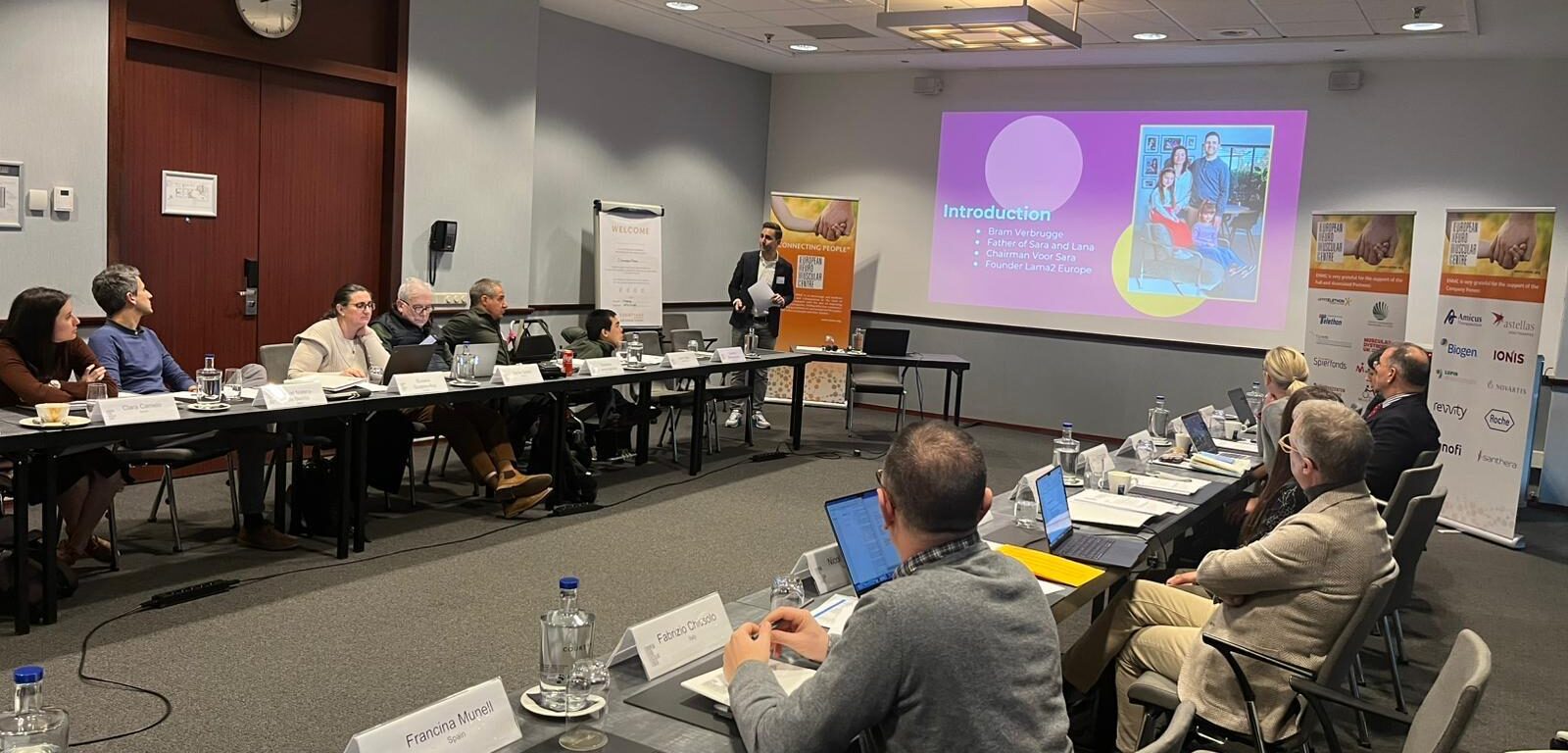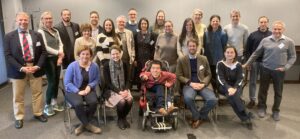
Historisch moment: publicatie van zorgrichtlijn Lama2-RD
Deze week is een belangrijke mijlpaal bereikt: er is een wetenschappelijke publicatie verschenen waarin een zorgrichtlijn voor LAMA2-patiënten is beschreven. Deze richtlijn is het resultaat van internationale samenwerking tijdens de ENMC-bijeenkomst die op initiatief van Stichting Voor Sara en Cure CMD in januari 2025 plaats vond. Deze publicatie markeert een grote stap in het standaardiseren van optimale zorg voor de LAMA2-gemeenschap.
(English version below)
Wat is deze richtlijn?
Een zorgrichtlijn is een document waarin artsen, onderzoekers en andere zorgverleners gezamenlijk aangeven wat de beste behandelopties, opvolgingsstrategieën en zorgstandaarden zijn voor mensen met LAMA2-gerelateerde spierziekte (LAMA2-RD). De richtlijn is geen “wet van Meden en Perzen”, maar eerder een kompas: een basis om te zorgen dat mensen, waar ook in de wereld, eenzelfde kwaliteit van zorg kunnen verwachten. In de komende tijd zal de richtlijn verder verfijnd worden en als een “living document” meegroeien naarmate nieuwe kennis wordt ontwikkeld. Ook tijdens de internationale conferentie in Istanbul zal hier aandacht voor zijn. Stichting Voor Sara en Maastricht University brengen bovendien een brochure uit met de belangrijkste aandachtspunten voor direct na de diagnose op een rijtje.
Waarom is deze richtlijn voor patiënten en families zo belangrijk?
- Betere zorg, overal
Deze richtlijn helpt artsen om consistent te handelen. Dat betekent dat iemand in Nederland, Spanje of waar ook ter wereld dezelfde standaarden kan ontvangen, in plaats van dat zorg erg varieert per ziekenhuis of regio. - Vroegtijdige signalering van complicaties
In de richtlijn wordt aandacht besteed aan zaken zoals ademhaling, operaties, gebruik van hulpmiddelen én een aspect dat voorheen minder bekend was: hypoglycemie (te lage bloedsuiker). Dit komt namelijk vaker voor bij LAMA2-patiënten dan gedacht. - Betere planning van zorg en ondersteuning
Families krijgen meer duidelijkheid over wat te verwachten is: welke onderzoeken of behandelingen kunnen voorkomen, welke hulpmiddelen mogelijk zijn, wanneer ingrijpen zinvol is, en waar het belang ligt van samenwerking tussen specialisten. - Stem van patiënten wordt gehoord
Tijdens de bijeenkomst spraken ook patiënten en families. Hun ervaringen — over ademhalingsproblemen, verzwakte spieren, gezichts- of spraakproblemen — werden meegenomen. Dat versterkt de richtlijn: hij is niet louter een wetenschappelijk document, maar een praktisch hulpmiddel dat écht rekening houdt met het leven van mensen.
Wat gaat er nu gebeuren?
De richtlijn is gepubliceerd als wetenschappelijk artikel (abstract beschikbaar op de website van het NMD-journal). Het is de start van een langere weg: onderzoekers en klinisch specialisten zullen de aanbevelingen verder finetunen en aanvullen.
De betrokken partijen streven ernaar om het document levend te houden — dat wil zeggen: te blijven actualiseren als er nieuwe onderzoeksresultaten binnenkomen en als de praktische ervaringen van patiënten groeien.
Hoe ziet dit eruit voor jou?
Als patiënt of familielid kun je hierop letten:
- Vraag aan je behandelend arts of hij of zij bekend is met deze nieuwe richtlijn en of de zorg in jullie ziekenhuis eraan voldoet.
- Vraag of de zorginstelling bereid is aanpassingen te maken, bijvoorbeeld in preventie, controle of hulpmiddelengebruik, op basis van de richtlijn.
- Deel je eigen ervaringen: hoe was jouw reis met LAMA2-zorg, welke knelpunten zie je, wat heb je gemist? De Lama2-conferentie in Istanbul is dé plek voor interactie met experts. Jouw verhalen voeden de richtlijn verder.
- Blijf op de hoogte: zodra de volledige richtlijn (met toelichting) openbaar is, komt Stichting Voor Sara met een heldere uitleg zodat ook niet-medische lezers het kunnen begrijpen.
Deze publicatie is niet het eindpunt, maar een begin — een signaal dat we samen toe naar betere, meer gelijke zorg voor iedereen met LAMA2. Voor Sara is trots op wat bereikt is, en vastbesloten om betrokken te blijven. Want voor elke patiënt telt elke stap vooruit.
Please accept marketing-cookies to watch this video.
Berdien, Mika and Amber, three Dutch Lama2-RD patients, talk about their experiences and challenges because of this ultra rare muscular dystrophy.
English version
This week marks an important milestone: a scientific publication has been released describing a care guideline for LAMA2 patients. These guidelines are the result of international collaboration during the ENMC meeting that took place in January 2025 on the initiative of the Voor Sara Foundation and Cure CMD. This publication marks a major step forward in standardising optimal care for the LAMA2 community.
What are these guidelines?
A care guideline is a document in which doctors, researchers and other healthcare providers jointly indicate the best treatment options, follow-up strategies and care standards for people with LAMA2-related muscular disease (LAMA2-RD). The guideline is not set in stone, but rather a compass: a basis for ensuring that people anywhere in the world can expect the same quality of care. In the coming period, the guideline will be further refined and will evolve as a “living document” as new knowledge is developed. This will also be discussed during the international conference in Istanbul. The Voor Sara Foundation and Maastricht University are also publishing a brochure listing the most important points to consider immediately after diagnosis.
Why is this guideline so important for patients and families?
- Better care, everywhere
This guideline helps doctors to act consistently. This means that someone in the Netherlands, Spain or anywhere else in the world can receive the same standards of care, rather than care varying greatly from hospital to hospital or region to region.
- Early detection of complications
The guideline addresses issues such as breathing, surgery, the use of medical devices and an aspect that was previously less well known: hypoglycaemia (low blood sugar). This is more common in LAMA2 patients than previously thought.
- Better planning of care and support
Families are given more clarity about what to expect: which tests or treatments may be necessary, which aids are available, when intervention is appropriate, and the importance of cooperation between specialists. - Patients’ voices are heard
Patients and families also spoke at the meeting. Their experiences — of breathing problems, weakened muscles, facial or speech problems — were taken into account. This strengthens the guideline: it is not merely a scientific document, but a practical tool that truly takes people’s lives into account.
What happens now?
The guideline has been published as a scientific article (abstract available on the NMD journal website). This is the start of a longer process: researchers and clinical specialists will further refine and supplement the recommendations.
The parties involved aim to keep the document alive — that is, to continue updating it as new research results come in and as patients’ practical experiences grow.
What does this mean for you?
As a patient or family member, you can pay attention to the following:
- Ask your treating physician or neurologist if he or she is familiar with this new guideline and whether the care provided at your hospital complies with it.
- Ask whether the healthcare institution is willing to make adjustments, for example in prevention, monitoring or the use of aids, based on the guideline.
- Share your own experiences: what was your journey with LAMA2 care like, what bottlenecks do you see, what did you miss? The Lama2 conference in Istanbul is the place to interact with experts. Your stories will further inform the guideline.
- Stay informed: as soon as the full guideline (with explanatory notes) is published, the Voor Sara Foundation will provide a clear explanation so that non-medical readers can also understand it.
This publication is not the end point, but a beginning — a signal that together we are moving towards better, more equal care for everyone with LAMA2. Voor Sara is proud of what has been achieved and determined to remain involved. We would like to thank all the experts for their tremendous efforts. Because for every patient, every step forward counts.
